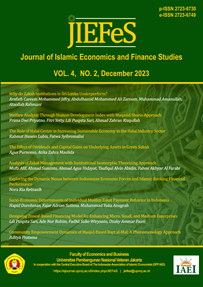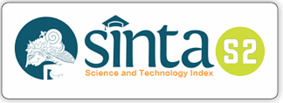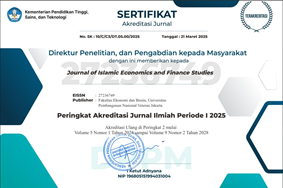Exploring the Dynamic Nexus between Indonesian Economic Forces and Islamic Banking Financial Performance
DOI:
https://doi.org/10.47700/jiefes.v4i2.6581Keywords:
Consumer Price Index, Exchange Rate, Financial Performance, Interest RateAbstract
World economic uncertainty during the pandemic resulted in a decline in overall economic activity. This has an impact on the financial performance of Islamic banks, especially those related to business and consumer financing. Most customers face financial difficulties and ultimately have the potential for increased credit risk. So, there is a mutual connection between macroeconomic indicators and the financial performance of Islamic banks. This research aims to measure the magnitude of the influence of economic variables on the financial performance of Indonesian Sharia Banking for the period 2020 quarter 1 to 2022 quarter 4. The method used in this quantitative research is Panel Vector Autoregressive (PVAR). The research results show that the exchange rate significantly affects Islamic banks' financial performance. In the long term, exchange rate shocks positively impact the FDR and NPF variables, while the ROA and CAR variables give a negative response. The exchange rate also makes the largest contribution to all financial performance variables compared to interest rates and the consumer price index. The implication is for policymakers to always maintain domestic economic stability, especially the exchange rate. Exchange rate stability reflects price stability as measured by inflation and will have an impact on other economic indicators.
Ketidakpastian ekonomi dunia selama pandemi mengakibatkan penurunan aktivitas ekonomi secara keseluruhan. Hal ini berdampak pada kinerja keuangan bank syariah terutama yang terkait dengan pembiayaan bisnis dan konsumen. Sebagian besar nasabah menghadapi kesulitan keuangan dan pada akhirnya berpotensi pada peningkatan resiko kredit. Sehingga terdapat keterikatan satu sama lain antara indicator perekonomian makro dan kinerja keuangan bank syariah. Penelitian ini bertujuan untuk mengukur besarnya pengaruh variabel ekonomi terhadap kinerja keuangan Perbankan Syariah Indonesia periode tahun 2020 triwulan 1 sampai dengan tahun 2022 triwulan 4. Metode yang digunakan dalam penelitian kuantitatif ini adalah Panel Vector Autoregressive (PVAR). Hasil penelitian menunjukkan bahwa nilai tukar berpengaruh signifikan terhadap kinerja keuangan bank syariah. Dalam jangka panjang guncangan nilai tukar memberikan dampak positif terhadap variabel FDR dan NPF, sedangkan variabel ROA dan CAR memberikan respon negatif. Selain itu, nilai tukar juga memberikan kontribusi paling besar terhadap seluruh variabel kinerja keuangan dibandingkan tingkat suku bunga dan indeks harga konsumen. Implikasinya bagi pengambil kebijakan untuk selalu menjaga stabilitas perekonomian dalam negeri, khususnya nilai tukar. Stabilitas nilai tukar mencerminkan stabilitas harga yang diukur dengan inflasi dan akan berdampak pada indikator perekonomian lainnya.
References
Antonio, M. S., Hafidhoh, H., & Fauzi, H. (2013). the Islamic Capital Market Volatility: a Comparative Study Between in Indonesia and Malaysia. Buletin Ekonomi Moneter Dan Perbankan, 15(4), 391–415. https://doi.org/10.21098/bemp.v15i4.73
Apriadi, I., Sembel, R., Santosa, P. W., & Firdaus, M. (2017). KOMPETISI DAN STABILITAS PERBANKAN DI INDONESIA Suatu Pendekatan Analisis Panel Vector Autoregression. Jurnal Manajemen, 21(1), 33. https://doi.org/10.24912/jm.v21i1.146
Ekananda, M. (2017). Macroeconomic Condition and Banking Industry Performance in Indonesia. Buletin Ekonomi Moneter Dan Perbankan, 20(1), 71–98. https://doi.org/10.21098/bemp.v20i1.725
Habir, M. T., & Wardana, W. (2020). COVID-19’s impact on Indonesia’s economy and financial markets. ISEAS-Yusof Ishak Institute, 142, 1–13. https://www.csis.org/programs/southeast-asia-program/southeast-asia-covid-19-tracker-0
Istan, M., & Fahlevi, M. (2020). The Effect of External and Internal Factors on Financial Performance of Islamic Banking. Jurnal Ekonomi & Studi Pembangunan, 21(1). https://doi.org/10.18196/jesp.21.1.5036
Karim, N. A., Al-Habshi, S. M. S. J., & Abduh, M. (2016). Macroeconomics Indicators and Bank Stability: a Case of Banking in Indonesia. Buletin Ekonomi Moneter Dan Perbankan, 18(4), 431–448. https://doi.org/10.21098/bemp.v18i4.609
Kasri, R. A., & Azzahra, C. (2020). Determinants of Bank Stability in Indonesia. Signifikan: Jurnal Ilmu Ekonomi, 9(2), 153–166. https://doi.org/10.15408/sjie.v9i2.15598
Keshtgar, N., Pahlavani, M., & Mirjalili, S. (2020). No TitleThe Impact of Exchange Rate volatility on Banking Performance (case of Iran). International Journal of Business and Development, 12(1), 39–56.
Ma, X., Sun, S., Liu, X. C., Ding, C., Chen, Z., & Wang, Y. (2018). A time-varying parameters vector auto-regression model to disentangle the time varying effects between drivers’ responses and tolling on high occupancy toll facilities. Transportation Research Part C: Emerging Technologies, 88(May 2017), 208–226. https://doi.org/10.1016/j.trc.2018.01.025
Maigua, C., & Mouni, G. (2016). Influence of Interest Rates Determinants on the Performance of Commercial Banks in Kenya. International Journal of Academic Research in Accounting, Finance and Management Sciences, 6(2), 121–133. https://doi.org/10.6007/ijarafms/v6-i2/2078
Mankiw, N. (1997). Real business cycles. A Macroeconomics Reader, 3, 79–90. https://doi.org/10.4324/9780203443965.ch18
Marlina, L., & Sudana. (2022). Economic Growth , Inflation and Growth of Islamic Bank in Indonesia during Covid-19. Budapest International Research and Critics Institute (BIRCI-Journal) : Humanities and Social Sciences, 5(3), 26697–26708.
Milennia, C. P., & Mesta, H. A. (2022). Comparative Analysis of the Financial Performance of Islamic and Conventional Banking Before and During the Covid-19 Pandemic. Financial Management Studies, 2(1), 30–43.
Mishkin, F. S. (2007). The economics of money, banking, and financial markets. In Policy. http://scholar.google.com/scholar?hl=en&btnG=Search&q=intitle:The+Economics+of+Money,+Banking,+and+Financial+Markets#0
Moyo, D., & Tursoy, T. (2020). No TiImpact of Inflation and Exchange Rate on the Financial Performance of Commercial Banks in South Africa tle. MPRA Paper.
Osundina, C. K., Osunidina, J. A., Jayeoba, O. O., & Olayinka, I. M. (2016). Exchange Rate Volatility and Banks Performance : Evidence from Nigeria Exchange Rate Volatility and Banks Performance: Evidence from Nigeria. International Journal of Economics and Business Management, 2(4), 1–11.
Pambuko, Z. B., Ichsan, N., & Anto, M. H. (2018). Islamic Banks’ Financial Stability and Its Determinants: a Comparison Study With Conventional Banks in Indonesia. Iqtishadia, 11(2), 371. https://doi.org/10.21043/iqtishadia.v11i2.3346
Rezitis, A. N., & Ahammad, S. M. (2015). Energy consumption and economic growth in South and Southeast Asian countries: Evidence from a dynamic panel data approach. International Energy Journal, 15(3), 103–116.
Saiymova, M., Troyanskaya, M., Shalgimbayeva, K., Babazhanova, Z., & Jumabekova, R. (2023). The Vector Auto Regression Analysis of the Link between Renewable Energy Consumption and Economic Development for Turkey and Kazakhstan. International Journal of Energy Economics and Policy, 13(2), 309–315. https://doi.org/10.32479/ijeep.13998
Sari, W. N. I., Setyowati, E., Putri, S. M., & Faridatussalam, S. R. (2022). Analysis of the Effect of Interest Rates, Exchange Rate Inflation and Foreign Investment (PMA) on Economic Growth in Indonesia in 1986-2020. Proceedings of the International Conference on Economics and Business Studies (ICOEBS 2022), 655(Icoebs), 313–320. https://doi.org/10.2991/aebmr.k.220602.041
Shah, S. S. H., Gherghina, Ștefan C., Dantas, R. M., Rafaqat, S., Correia, A. B., & Mata, M. N. (2023). The Impact of COVID-19 Pandemic on Islamic and Conventional Banks’ Profitability. Economies, 11(4), 1–17. https://doi.org/10.3390/economies11040104
Sharif, B. M. Al. (2021). Impact of Real Exchange Rate and Real Interest Rate on Islamic Bank’Performance: An Empirical Study. Indian Journal of Economics and Business, 20(3), 445–460. https://www.researchgate.net/profile/Bader-Alsharif-2/publication/356193798_Impact_of_Real_Exchange_Rate_and_Real_Interest_Rate_on_Islamic_Bank’_Performance_An_Empirical_Study/links/6191758007be5f31b781bb16/Impact-of-Real-Exchange-Rate-and-Real-Interest-R
Surahman, S., Kamal, I., Rosari, R., Susilowati, E., & Cakranegara, P. A. (2022). The Impact of the Covid-19 Pandemic on Banking Risks and Performance. Budapest International Research and Critics Institute-Journal (BIRCI-Journal), 5(1), 3248–3254. www.bircu-journal.com/index.php/birci email:
Taiwo, A., & Olayemi, S. O. O. (2015). Re-examine foreign direct investment and economic growth: Panel co-integration and causality tests for sub-Saharan African countries. International Area Studies Review, 18(1), 73–86. https://doi.org/10.1177/2233865914554469
Valeriani, D., Dalimunthe, D. Y., Wulandari, A., & Ashar, M. F. (2019). Vector auto regression analysis between export, economic growth, and job opportunity in bangka belitung islands province. Humanities and Social Sciences Reviews, 7(4), 677–684. https://doi.org/10.18510/hssr.2019.7487
Widagdo, A. K., & Ika, S. R. (2009). The Interest Prohibition and Financial Performance of Islamic Banks: Indonesian Evidence. International Business Research, 1(3). https://doi.org/10.5539/ibr.v1n3p98
Zaefarian, G., Iurkov, V., & Koval, M. (2022). Variance decomposition analysis: What is it and how to perform it – A complete guide for B2B researchers. Industrial Marketing Management, 107(March), 315–322. https://doi.org/10.1016/j.indmarman.2022.10.020
Zeqiraj, V., Mrasori, F., Iskenderoglu, O., & Sohag, K. (2021). Dynamic impact of banking performance on financial stability: Fresh evidence from southeastern Europe. Journal of Central Banking Theory and Practice, 10(1), 165–181. https://doi.org/10.2478/jcbtp-2021-0008
Downloads
Published
Issue
Section
License
Copyright (c) 2023 Nora Ria Retnasih

This work is licensed under a Creative Commons Attribution 4.0 International License.
Authors who publish with this journal agree to the following terms:
- Authors retain copyright and grant the journal right of first publication with the work simultaneously licensed under a Creative Commons Attribution 4.0 International License that allows others to share the work with an acknowledgment of the work's authorship and initial publication in this journal.
- Authors can enter into separate, additional contractual arrangements for the non-exclusive distribution of the journal's published version of the work (e.g., post it to an institutional repository or publish it in a book), with an acknowledgment of its initial publication in this journal.
- Authors are permitted and encouraged to post their work online (e.g., in institutional repositories or on their website) before and during the submission process, as it can lead to productive exchanges, as well as earlier and greater citation of published work.

This work is licensed under a Creative Commons Attribution 4.0 International License.











